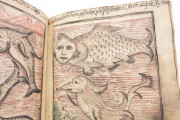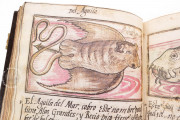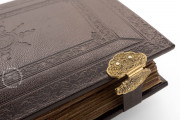The bestiary of John of Austria is a unique example of bestiary written in Castillian. The codex was made between 1570-1571 and it is now preserved in the Monasterio de Santa Maria de la Vid (Burgos) in Spain. Because it is written in Spanish and displays an exuberant decoration, the manuscript stands out among the Medieval and Renaissance production of bestiaries. Illuminated with vivid and stylized images of natural science, the book is also remarkable for bearing an illustrated treatise on the art of Falconry.
Charming Images of Animals
The author of the bestiary is Martín Villaverde, who is mentioned in the codex with the abbreviated name Villaxide. Martín Villaverde dedicated the manuscript to John of Austria (1547-1578), the illegitimate brother of King Philip II of Spain, who distinguished himself as a military commander, especially at the Battle of Lepanto. The dedication explains that the book was meant to entertain John of Austria during his rest when he was not at war. The large manuscript contains 484 pages filled with wonderful creatures rendered in colored illustrations.
The genre of the bestiaries had a long tradition that dated back to the Early Christianity. In the second century AD, an anonymous author wrote the renowned Physiologus, a Greek text that describes animals, fantastic creatures, stones, and plants explaining the moral content related to the natural world. To the knowledge of famous naturalists such as Aristotle, Pliny, Aelianus, and Dioscorides, the Physiologus added the symbolic meanings of the fantastic creatures presented in the bestiaries. In a similar fashion, the bestiary of John of Austria underlines the moral values of animals and birds.
The Symbolic Value of the Real and Imaginary Animals
The Physiologus had great fortune during the Middle Ages and became one of the most famous books after the Bible. The genre of the bestiaries was shaped on the model of the Physiologus. Following this tradition, the bestiary of John of Austria had a didactic purpose.
The representation of mysterious animals, some of imaginary and disturbing shapes and dimensions, might have inspired admiration and curiosity for these impressive creatures. They were matter of study, but also a source of social wisdom. These symbolic beasts could reflect spiritual meanings. For example, the butterfly or the first swallow that comes with the warm weather could evoke the resurrection of Christ. The grey donkey with a white cross marked on its back was an image of the way to the Calvary and therefore of the difficulties that people meet in the world.
We have 1 facsimile edition of the manuscript "Bestiary of John of Austria": Bestiario de Don Juan de Austria facsimile edition, published by Siloé, arte y bibliofilia, 1998
Request Info / Price























